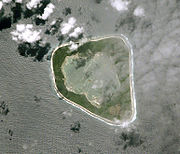
Manra Island
Encyclopedia

Manra Island or Sydney Island, is one of the Phoenix Islands
Phoenix Islands
The Phoenix Islands are a group of eight atolls and two submerged coral reefs, lying in the central Pacific Ocean east of the Gilbert Islands and west of the Line Islands. They are a part of the Republic of Kiribati. During the late 1930s they became the site of the last attempted colonial...
in the Republic of Kiribati
Kiribati
Kiribati , officially the Republic of Kiribati, is an island nation located in the central tropical Pacific Ocean. The permanent population exceeds just over 100,000 , and is composed of 32 atolls and one raised coral island, dispersed over 3.5 million square kilometres, straddling the...
. It lies at 4°27′S 171°16′W. W. longitude, and has an area of 4.4 km2. and an elevation of approximately six meters. Together with the seven other Phoenix Islands, it forms part of the Phoenix Islands Protected Area, the world's largest marine protected area.
Though it has been occupied at various times in the past (including as late as 1963), Manra is currently uninhabited.
Flora and fauna
Manra is triangular in shape, measuring approximately 3.2 km by 2.8 km. It completely surrounds a hyper-saline lagoon without outlet to the sea, containing depths of five to six meters. The island is covered with coconut palms, scrub forest, herbs and grasses, including the species Tournefortia, Pisonia, Morinda, Cordia, Guettarda, and Scaevola. Manra was formerly a functioning copraCopra
Copra is the dried meat, or kernel, of the coconut. Coconut oil extracted from it has made copra an important agricultural commodity for many coconut-producing countries. It also yields coconut cake which is mainly used as feed for livestock.-Production:...
plantation, though it is no longer.
Bird life is similar to the other Phoenix Islands, but has been described as "less abundant". Hermit crabs and rats are plentiful on the island, which also supports colonies of feral dogs, pigs and cats. According to E.H. Bryan, "insects are abundant, including a blue and white butterfly, several kinds of moths, dragonflies, ants, flies, leafhoppers, bugs, beetles, wasps, and spiders". Mosquitoes arrived in the late 19th century, on a ship from Tahiti.
The lagoon is too salty to support marine life, but fish are abundant around the fringing reef and offshore waters. Many Manra fish are reputed to be poisonous, due to certain seaweeds that form part of their diet. H.E. Maude, in his 1937 report: Colonization of the Phoenix Islands, indicated that visitors to the island refused to eat any fish caught there. Bryan, on the other hand, insisted that the reef contains other fish species that made "excellent eating".
A color photo of Manra can be seen at.
History
Unlike some of the other Phoenix Islands, Manra contains definite evidence of prehistoric inhabitation, in the form of at least a dozen platforms and remains of enclosures in the northeast and northwest portions of the island. K.P. Emory, ethnologist at Honolulu's Bishop MuseumBishop Museum
The Bishop Museum , is a museum of history and science in the historic Kalihi district of Honolulu on the Hawaiian island of O'ahu...
, estimated that two groups of people were present there, one from eastern Polynesia, the other from Micronesia. Wells and pits from these early inhabitants were also found.
Manra was discovered in 1823 from the London whaling ship Sydney Packet, T. Emmett Master, and was called Sydney. It is the birthplace of Sydney (Arundel) Aris (1884–1966), daughter of Lillie Arundel and John T. Arundel
John T. Arundel
John T. Arundel was an entrepreneur who was instrumental in the development of the mining of phosphate rock on the Pacific islands of Nauru and Banaba ....
, who was named after the island on which John T. Arundel
John T. Arundel
John T. Arundel was an entrepreneur who was instrumental in the development of the mining of phosphate rock on the Pacific islands of Nauru and Banaba ....
& Co. were then engaged in mining guano. Extensively mined for guano in the late 19th century, Manra was turned into a coconut plantation in the early 20th century. Later, it became one of the islands involved in the Phoenix Islands Settlement Scheme
Phoenix Islands Settlement Scheme
The Phoenix Islands Settlement Scheme was begun in 1938 in the western Pacific ocean and was the last attempt at human colonisation within the British Empire.Conceived by Henry E...
, the final colonial expansion of the British Empire
British Empire
The British Empire comprised the dominions, colonies, protectorates, mandates and other territories ruled or administered by the United Kingdom. It originated with the overseas colonies and trading posts established by England in the late 16th and early 17th centuries. At its height, it was the...
. Approximately 130 settlers were imported, and a village constructed complete with radio shack, cement cistern and 15 water wells. Each adult settler was given fifty coconut palms, and each child granted two unplanted sections, 150 feet (80 m) square. Ultimately, the colony failed, due to prolonged drought and the declining world market for copra.
Manra was completely abandoned between 1958 and 1963, and remains uninhabited today.
The island was declared a bird sanctuary in 1938, and a wildlife sanctuary in 1975. In 2008, it became, together with the other Phoenix Islands, part of the Phoenix Islands Protected Area
Phoenix Islands Protected Area
The Phoenix Islands Protected Area is located in the Republic of Kiribati, an ocean nation in the central Pacific approximately midway between Australia and Hawaii. PIPA constitutes 11.34% of Kiribati’s Exclusive Economic Zone and with a size of it is the largest marine protected area in the...
, the largest marine protected area in the world.
Sources
- Maude, Henry Evans: Of islands and men : studies in Pacific history; Melbourne [u.a.] : Oxford University Press, 1968
- Jones, A. G. E.: Ships employed in the South Seas trade Vol. 1: 1775 - 1861; Canberra 1986 & Vol. 2: 1775 - 1859; Burwood, Vic. [1992]

